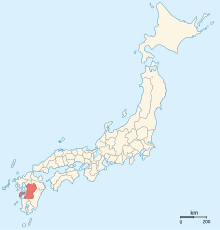Higo Province

Higo ( Japanese 肥 後 国 Higo no kuni ) was one of the provinces of Japan in the area of today's Kumamoto Prefecture on the island of Kyūshū . Higo bordered on Chikugo , Bungo , Hyūga , Ōsumi, and Satsuma .
The province emerged from the splitting of the province Hi into the provinces of Hizen ("Front-Hi") and Higo ("Behind-Hi"). Both countries together were therefore later referred to as Hishū ( 肥 州 'Hi provinces' ), Nihi ( 二 肥 'the two Hi' ) and Ryōhi ( 両 肥 'the two Hi' ). Higo was first mentioned around 696 in the Shoku Nihongi .
The provincial capitals ( kokufu ) of Higo were probably in what is today Kumamoto . During the Muromachi period , Higo was held by the Kikuchi clan. However, this was expropriated in the Sengoku period , and the province was occupied by the rulers of the neighboring areas, such as. B. the Shimazu from Satsuma Province . Eventually, Toyotomi Hideyoshi attacked the island of Kyushu, leaving Higo to his followers Sasa Narimasa and later Kato Kiyomasu .
In the Sengoku period, Higo was an important center of Christianity in Japan . The samurai Miyamoto Musashi stayed there at the invitation of the daimyo while he was finishing his book of the five rings .
Coordinates: 32 ° 41 ′ N , 130 ° 52 ′ E